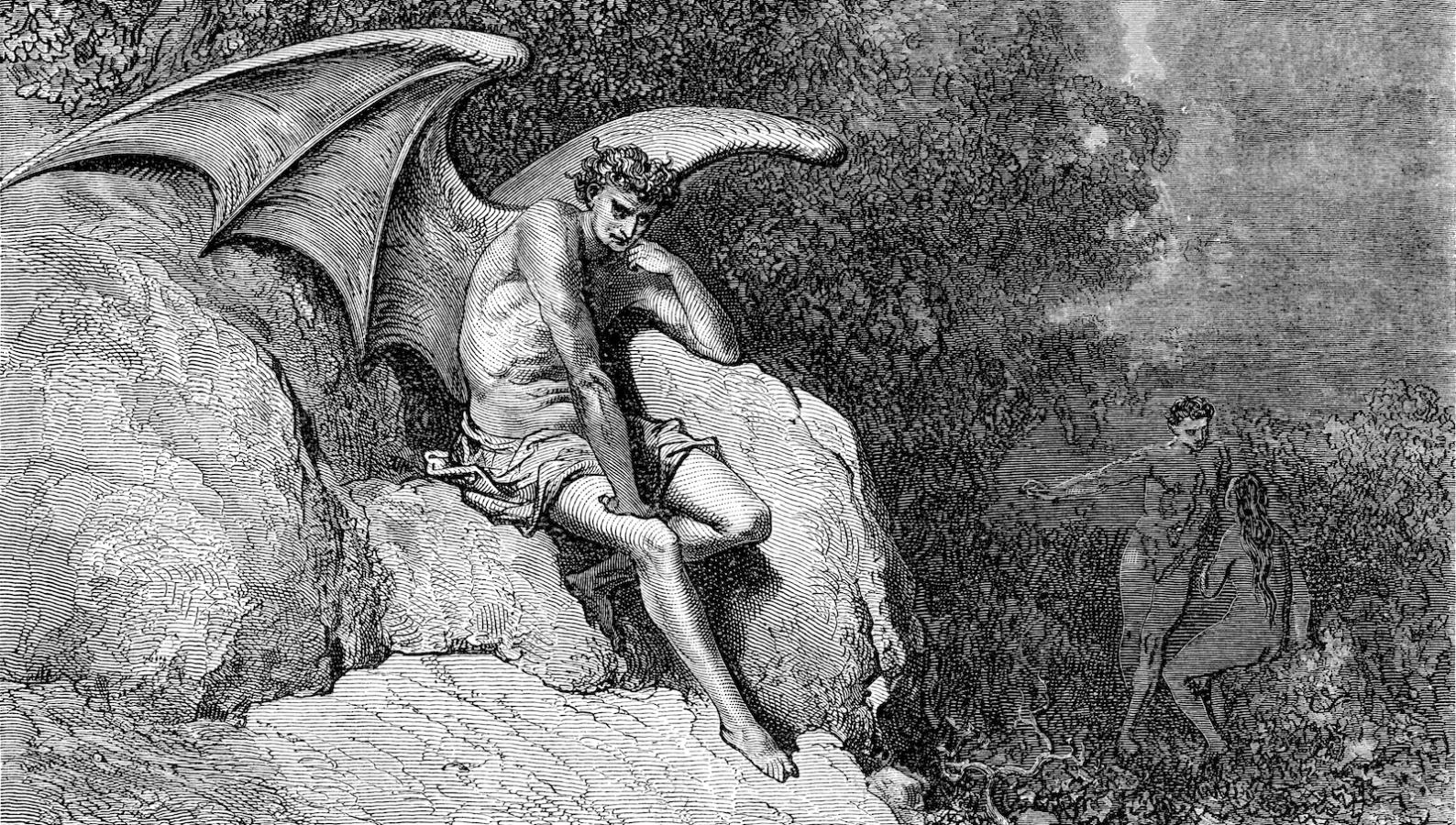Satan occupies a prominent place in Christianity, which generally regards him as a rebellious angel and the source of evil who will meet his ultimate demise in battle at the End of Days. Jewish sources on the whole don’t dwell as much on the satanic, but the concept is nonetheless explored in numerous texts.
Satan appears in the Bible, was discussed by the rabbis of the Talmud and is explored in detail in Jewish mysticism, or Kabbalah. In Hebrew, the term Satan is usually translated as “opponent” or “adversary,” and he is often understood to represent the sinful impulse (in Hebrew, yetzer hara) or, more generally, the forces that prevents human beings from submitting to divine will. He is also sometimes regarded as a heavenly prosecutor or accuser, a view given expression in the Book of Job, where Satan encourages God to test his servant.
Kabbalistic sources expand the view of Satan considerably, offering a rich and detailed portrayal of the demonic realm and the forces of evil in the world, which are to be warded off in some cases with various forms of magic, from amulets to exorcisms.
Satan in the Bible
The Bible contains multiple references to Satan. The word appears just twice in the Torah, both times in the story of Balaam, the seer who is asked by the Moabite king Balak to curse the Jews. When Balaam goes with Balak’s emissaries, God places an angel in his path “l’satan lo” — as an adversary for him. The term appears in multiple other instances in the Prophets, often in a similar context — referring not to a specific figure as the Satan, but rather as a descriptor for individuals who act as a satan, i.e. as adversaries.
Only twice in the Hebrew Bible does Satan appear as a specific figure, as HaSatan — the Satan. One is a brief reference in the Book of Zecharia, where the high priest is described as standing before a divine angel while Satan stands at his right to accuse him. The other is in the Book of Job, where Satan has a central role in the story as an angel in the divine court. According to the biblical narrative, Satan — here too commonly translated as the Adversary — seems to urge God to create hardship for his righteous servant Job, arguing that Job is faithful only on account of his wealth and good fortune. Take those away, Satan claims, and Job will blaspheme. God permits Satan to take away Job’s wealth, kill his family and afflict him physically, none of which induces Job to rebel against God.
The Book of Job is sometimes cited to support the claim that the Jewish view of Satan as an agent of God is different from the Christian view, which sees Satan as an autonomous force opposed to God. In the story, Satan inflicts suffering on a human being and seeks to induce him to sin — but only with God’s permission.
Satan in the Talmud
Satan makes many appearances in the Talmud. A lengthy passage in the tractate Sanhedrin accords Satan a central role in the biblical story of the binding of Isaac. According to Rabbi Yehoshua ben Levi, it was Satan that caused the Jewish people to despair of Moses returning from Mount Sinai by showing them an image of the prophet on his deathbed. A passage in the tractate Megillah says that Satan dancing at the party of the Persian King Ahasuerus is what led to the killing of Queen Vashti in the Purim story.
In Tractate Bava Batra, Reish Lakish says that Satan, the yetzer hara and the Angel of Death are all one. Maimonides, the medieval Jewish philosopher, endorses this position in his Guide for the Perplexed. The word Satan, Maimonides writes, derives from the Hebrew root for “turn away.” Like the evil inclination, Satan’s function is to divert human beings from the path of truth and righteousness. Maimonides seems not to believe Satan actually exists, but rather that he is a symbol of the inclination to sin. The entire Book of Job, he writes, is fictional, intended merely to elucidate certain truths about divine providence. And even if it is true, Maimonides continues, certainly the portion in which God and Satan speak with each other is merely a parable.
Satan in Kabbalah and Hasidism
The Jewish mystical tradition has much to say about Satan. Indeed, kabbalistic texts offer a rich description not merely of Satan, but of an entire realm of evil populated by demons and spirits that exists in parallel to the realm of the holy. Satan is known in Kabbalah as Sama’el (rendered in some sources as the Great Demon), and the demonic realm generally as the Sitra Achra — literally “the other side.” The consort of Sama’el (who is mentioned in pre-kabbalistic Jewish literature as well) is Lilith, a mythic figure in Jewish tradition more commonly known as the rebellious first wife of Adam.
The kabbalistic sources portray the demonic as a separate and oppositional realm in conflict with God. Kabbalah even offers explanations of the origins of the demonic realm, the most common of which is that this realm emerges when the attribute of God associated with femininity and judgment, is dissociated from the attribute of God associated with grace and masculinity, and becomes unconstrained. Evil, in this reading, results from an excess of judgment.
Many of these ideas would later find expression in Jewish folk beliefs and in the works of the Hasidic masters. Rabbi Yaakov Yosef of Poloniye, one of the chief disciples of Hasidism’s founder, the Baal Shem Tov, wrote in his Toldos Yaakov Yosef that God would eventually slaughter the angel of death during the messianic age — a belief that clearly echoes the Christian view of a final showdown between God and Satan at the End of Days. Hasidic folk tales are replete with descriptions of demonic forces, among them a famous story in which the Baal Shem Tov defends a group of children from a werewolf. Even today some Hasidic Jews will seek out protections from such forces in the form of amulets or incantations. Some Jewish communities, particularly in the Sephardic world, also prize amulets as protection from evil spirits and maintain a number of customs and rituals aimed at keeping those spirits at bay. Jewish sources dating back to biblical times including formulas for exorcisms to free the possessed of an evil spirit, known as a dybbuk.
Jewish vs. Christian Conceptions of Satan
On the whole, Satan occupies a far more prominent place in Christian theology than in traditional rabbinic sources. The Book of Revelation, in the New Testament, references an “ancient serpent” — commonly understood as the snake that tempted Eve in the Garden of Eden — “who is the Devil and Satan.” It describes a red dragon with seven heads and 10 horns that stands opposite a pregnant woman about to give birth in order to devour the child — that is, Jesus. Revelation further describes a war in heaven in which Satan is hurled to earth, where he proceeds to lead the world astray. (In the New Testament’s Book of Luke, Jesus says he saw Satan “fall like lightning from heaven.”) According to Christian prophecy, Satan will be bound by a chain for 1,000 years after the return of Jesus.
Some of these Christian ideas are echoed in Jewish tradition, but some also point to fundamental differences — most notably perhaps the idea that, in the Hebrew Bible at least, Satan is ultimately subordinate to God, carrying out his purpose on earth. Or that he isn’t real at all, but is merely a metaphor for sinful impulses.
The kabbalistic and Hasidic literature complicate this view, offering a closer parallel to Christian eschatology. Both the kabbalistic/Hasidic and Christian traditions describe the forces of the holy and the demonic as locked in a struggle that will culminate in God’s eventual victory. According to some scholars, this is born of the considerable cross-pollination between Christian and Jewish thinking in the so-called “golden age” of Jewish culture in Spain during the Middle Ages, from whence many of the early kabbalistic texts, including the Zohar, emerged.
Talmud
Pronounced: TALL-mud, Origin: Hebrew, the set of teachings and commentaries on the Torah that form the basis for Jewish law. Comprised of the Mishnah and the Gemara, it contains the opinions of thousands of rabbis from different periods in Jewish history.
Torah
Pronunced: TORE-uh, Origin: Hebrew, the Five Books of Moses.
Zohar
Pronounced: ZOE-har, Origin: Aramaic, a Torah commentary and foundational text of Jewish mysticism.
Sephardic
Pronounced: seh-FAR-dik, Origin: Hebrew, describing Jews descending from the Jews of Spain.



